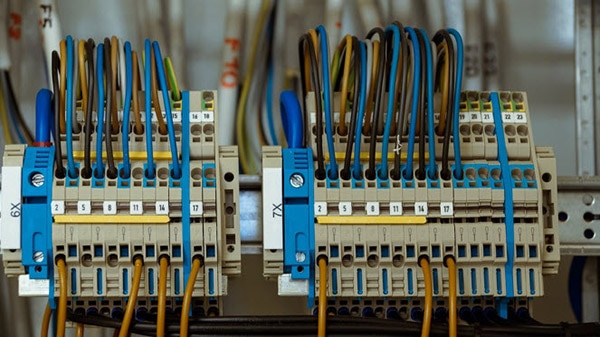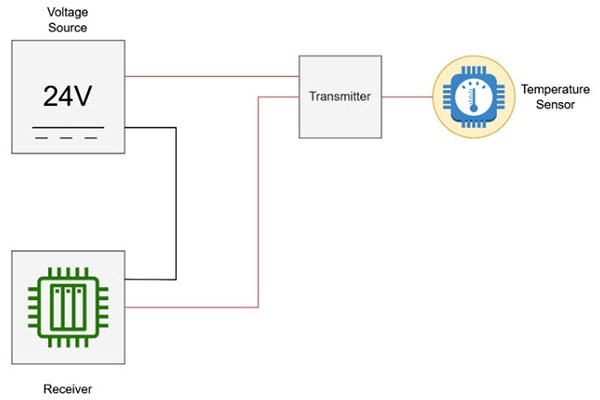What is the 4-20mA Communication Protocol and How Does it Work?
2023-10-23 | By Maker.io Staff
 Source: https://pixabay.com/photos/wire-cables-electric-network-1098059/
Source: https://pixabay.com/photos/wire-cables-electric-network-1098059/
Instead of encoding and transmitting data through changing voltage levels as is customary in voltage-based digital communication, the analog 4-20mA protocol utilizes the current strength in a signal line to send data. This article explores which applications benefit from using the 4-20mA protocol, how it functions in detail, and what advantages and drawbacks its use entails.
The Basic Principles of Current Loop Communication
Current, voltage, and resistance are three principal physical quantities in electrical systems, and Ohm’s law governs how they interact. Essentially, the current describes the electron flow in a closed circuit, resistance describes the force opposing the current, and the voltage represents the difference in electrical potential between any two points in a circuit.
Ohm’s law states that current is voltage over resistance, meaning that in a closed system with a known fixed voltage level — as is the case with 4-20mA communication — the only way to change the current that flows through a signal line is by altering the resistance. Lowering the resistance of a line leads to an increase in current flow, and conversely, an increase in resistance decreases the current.
In the 4-20mA communication protocol, the values 4mA and 20mA represent the minimum and maximum current flow used to encode and transmit values, such as the temperature measured by a sensor. The most commonly used voltage in industrial systems is 24V DC.
The Components of a 4-20mA Communication Loop
You often employ the 4-20mA protocol to transmit sensor measurements from a sensing device to a controller in industrial settings.
The sensor is the first component. Some measuring devices may require a dedicated converter that translates the measured values to a proportional current signal between 4mA and 20mA and transmits the result. This transmitter can actively regulate the resistance on the signal line to change the current representing the measured value. A controller, sometimes called the receiver, senses, and interprets the analog current signal to decode the transmitted value.
 This diagram illustrates the main components of a 4-20mA loop.
This diagram illustrates the main components of a 4-20mA loop.
An additional voltage regulator in the loop ensures that the voltage remains stable, and the current does not drop below 4mA or exceed 20mA. This device compensates for changes in sensor and loop resistance to keep the current within the specified range. When designing the loop, you must account for the voltage requirements, current flow, and resistance of the components in the loop and the wire.
Finally, the loop may contain protective components, such as fuses or additional fault-detection and redundancy measures.
Benefits and Drawbacks of the 4-20mA Protocol
The most substantial benefit of the 4-20mA protocol is that it is a widely accepted standard in industrial applications — meaning that many sensors and devices support the protocol natively. In addition, current-based communication usually exhibits better noise immunity than voltage-based communication, which is crucial in electrically noisy environments like factories. Current loops can transmit data even over large distances without significant signal degradation. Signal interpretation is relatively easy, and the fixed current range can also act as a zero to maximum scale. For instance, if a system contains a temperature sensor, it might output 4mA when the temperature is at its lowest and 20mA when the temperature is at its highest.
In contrast, the 4-20mA protocol is not well-suited for transmitting high-bandwidth data, as changing the current and stabilizing the voltage in the loop takes time. Implementing an analog communication loop can also be complex and costly, especially in larger installations. Performing all of the physical calculations can become difficult, especially when complex relationships are involved.
Summary
The 4-20mA communication protocol is a widely accepted standard for analog signal transmission in industrial applications. It involves varying the resistance in a fixed-voltage closed loop to alter the current flowing through the signal line — representing a value to transmit a sensor reading, for example.
The main components of the loop include the sensor, a transmitter, a receiver, a voltage regulator, the wiring, and additional safety equipment such as fuses.
The 4-20mA protocol offers noise immunity even in large-distance transmission, and interpreting the signals is easy. In addition, the fixed current range can represent absolute zero and maximum values. However, the protocol is not well-suited for high-bandwidth transmission, as altering the current in the loop takes significantly longer than changing the voltage in a digital transmission. The 4-20mA protocol typically involves more complex calculations and relationships between the components in the loop, making planning and implementation more costly.

Have questions or comments? Continue the conversation on TechForum, DigiKey's online community and technical resource.
Visit TechForum

















 中国
中国